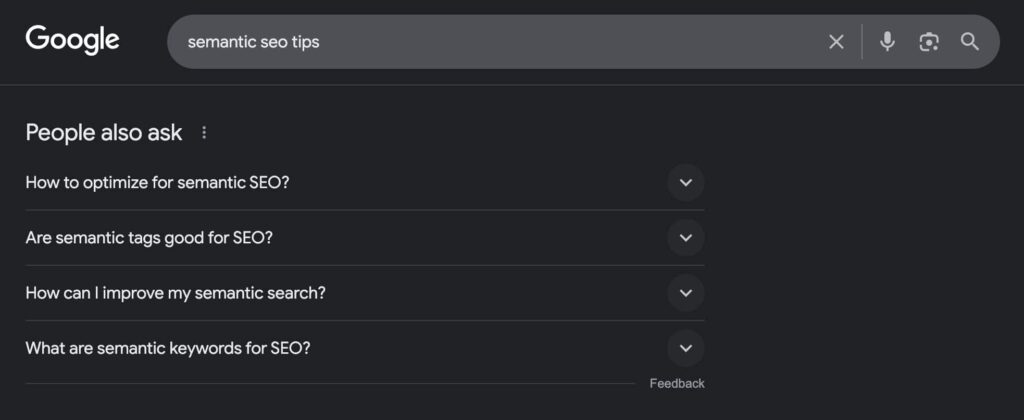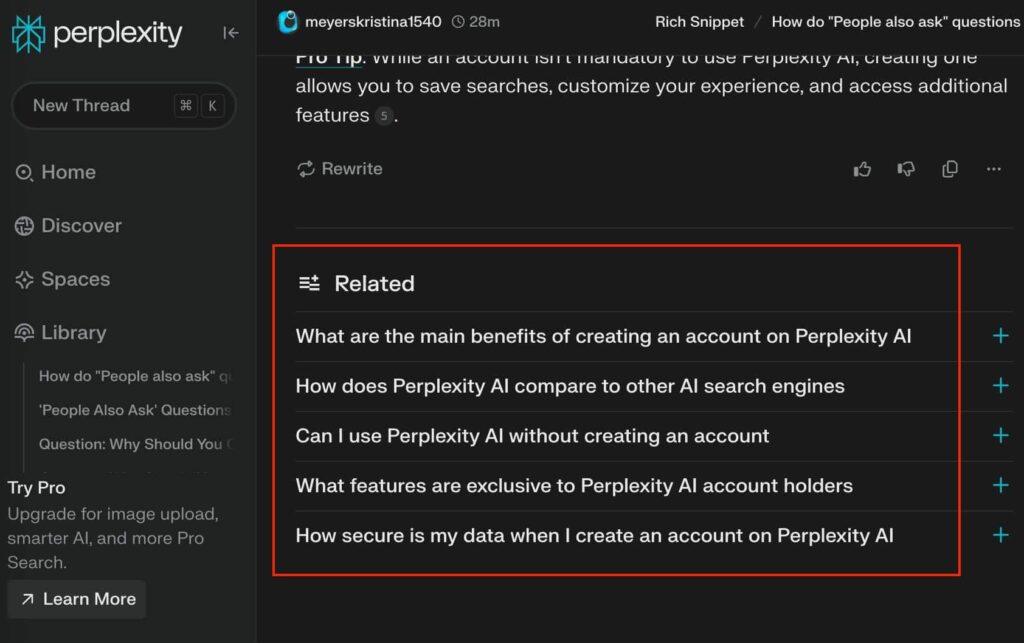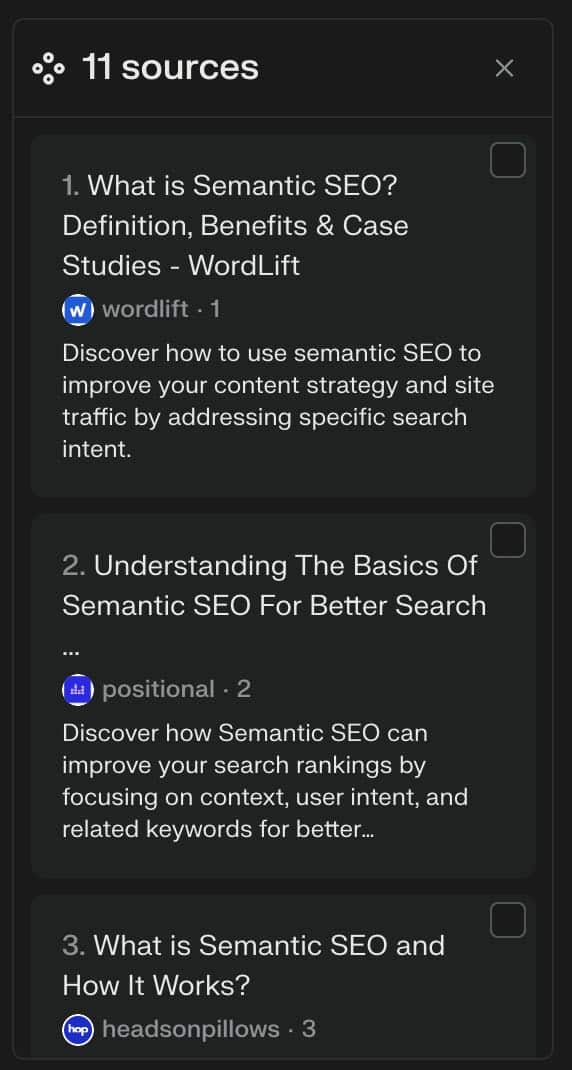
Perplexity is a research tool that can help content creators answer ‘People Also Ask’ (PAA) questions and improve their website’s search performance. In this guide, you’ll learn how to use Perplexity to create search-friendly content that boosts your SEO strategy.
Why Focus on People Also Ask (PAA) in SEO?
‘People Also Ask’ (PAA) questions are a valuable way to rank on the first page of Google, even if your site doesn’t hold a top organic position. Optimizing for PAA can drive more traffic to your website, increase your brand’s visibility, and strengthen your competitive edge.

Pro Tip: PAA questions provide insights into user search behavior, allowing you to create more nuanced, comprehensive content that goes beyond traditional keyword targeting.
Benefits of PAA Optimization:
- Increased Visibility: PAA boxes show up in over half of Google searches, offering prime real estate on the results page.
- More Traffic: PAA helps attract users looking for specific answers, often leading to higher engagement and conversions.
- Keyword Insights: PAA questions reveal low-competition keywords and uncover user intent, which can shape your content strategy.
- Boosted Brand Awareness: Showing up in PAA boxes positions your brand as a reliable source of information.
- Content Improvements: Answering PAA questions directly helps you meet user needs and improve your SEO performance.
Why Should You Care About Semantic SEO?
Semantic SEO focuses on the meaning behind content, not just keywords. It ensures search engines understand your content’s purpose, making it more likely to match user searches and keep visitors on your site. This strategy is key to improving user experience, reducing bounce rates, and boosting engagement.
How Perplexity Helps You Optimize for PAA and Semantic SEO
Perplexity AI can simplify the process of answering PAA questions and creating in-depth, search-friendly content. Here’s how:
1. Discover Contextual Questions
Perplexity is great at uncovering follow-up questions and related topics beyond basic PAA boxes. With its advanced language models, it can:
- Identify relevant questions users are asking.
- Suggest deeper, related topics by focusing on context and meaning instead of just keywords.

2. Generate Comprehensive Content
Use Perplexity to create detailed, helpful content that covers all angles of a topic. It draws from multiple authoritative sources to ensure accuracy and relevance.

3. Optimize for Semantic Depth
- Add Latent Semantic Indexing (LSI) keywords to help search engines grasp the full meaning of your content.
- Focus on user intent by creating content that directly answers their queries.
- Build topic clusters to connect related ideas and show expertise in your niche.
Step-by-Step: Using Perplexity AI for Semantic Search
Perplexity’s conversational tone and advanced capabilities make it easy to create natural, engaging content that aligns with Google’s focus on user experience. Here’s how to get started:
- Write for Voice Searches: Use conversational language and directly answer common questions.
- Cite High-Quality Sources: Perplexity assigns trust scores to domains. Make sure your content uses reliable, up-to-date sources.
- Focus on User Needs: Keep answers clear, concise, and actionable to meet searchers’ expectations.
What Questions Work Best with Perplexity?
Perplexity shines when answering specific or complex queries. Here are some examples:
1. Informational Queries
- Fact-based questions like, “What causes a solar eclipse?”
- Deep-dive research topics that need detailed answers.
2. Instructional Prompts
- Step-by-step guides like, “How do I set up a camping tent?”
- Tutorials that require clear, actionable instructions.
How to Signup for Perplexity
- Visit the official Perplexity AI website
- Click the “Sign up” button located in the bottom left corner
- Choose one of three sign-up methods: Google, Apple or Email.
Account Options
- Free Plan: Unlimited quick searches
- Pro Plan: Advanced features, costs approximately $20 per month
Related Topics:
- How Semantic SEO Impacts Google Scoring
- What is Semantic SEO and How Does It Impact Search Engine Ranking?
- SEO Secrets: A Comprehensive Guide of SEO Tips and Tricks To Rank Higher
- How to Use Perplexity AI for SEO Content
FAQs
What are best practices for PAA content?
To create effective PAA content, focus on directly answering the question in a clear, concise manner, ideally within 40-60 words. Use a conversational tone that mirrors how users might phrase their queries, and ensure the content is well-structured with headings or bullet points when appropriate. Incorporate relevant keywords and synonyms naturally to align with search intent, and include authoritative sources or data to support your answer. Additionally, provide depth by linking to related content on your site, which can keep users engaged and improve your internal linking strategy.
How does answering PAA questions improve semantic SEO?
People Also Ask (PAA) can improve semantic SEO rankings by boosting visibility, as PAA boxes often appear near the top of search results. They also create double ranking opportunities, allowing websites to potentially rank twice on the same search results page. Additionally, PAA questions offer valuable insights for content strategy by revealing keywords and topic ideas that can help guide targeted content creation.
How can I identify the most common “People also ask” questions for my niche?
To identify the most common “People Also Ask” (PAA) questions for your niche, start by researching keywords relevant to your industry using tools like Google Keyword Planner, NeuronWriter’s PAA tool, or Ahrefs. Tools like AnswerThePublic and AlsoAsked can help uncover related questions and map them to broader topics. Analyze your competitors’ content to see which PAA questions they address and use this data to refine your strategy. Focus on questions that align with your audience’s search intent and offer opportunities for detailed, authoritative answers.
Conclusion
Using Perplexity to answer PAA questions not only improves your site’s visibility but also positions your content as a helpful resource. By combining PAA optimization with semantic SEO strategies, you’ll build a stronger online presence and attract the right audience to your site.